*This post may contain affiliate links. Read more »
The name Bubur Cha Cha just translates to “Mixed Porridge” in Malay, which, let's be real, actually isn't that cute sounding at all. But have you seen this stuff? OMG it's like you died and woke up with the care bears in candy-land heaven. And this bubur cha cha recipe's been battle tested by over 400 recipe testers from all around the planet, so you know it slaps extra-hard.


Enter your email & I'll send it to your inbox. Plus, get great new recipes from me every week!
By submitting this form, you consent to receive emails from Cinnamon Snail.
Like other Malaysian sweets (such as Kuih ketayap, and ondeh ondeh) it relies on pandan, coconut, and other ingredients that are especially abundant in Malaysia and Indonesia.
This beloved treat is cherished by the Hokkien-Chinese community. Bubur Cha Cha is traditionally savored on Chap Goh Meh, the “Chinese Valentine’s Day,” on the 15th and final day of the Chinese New Year celebrations. It symbolizes a year filled with prosperity, as ‘cha cha’ echoes the Hokkien phrase ‘lui che che,’ signifying ‘lots of money’.
If you’re a first-time Bubur Cha Cha maker, don’t dismay! This recipe is fine-tuned to make sure that your first attempt goes smoothly. You’ll put together a dessert that’s as slammin’ as any you’d find in a Malaysian eatery. You will make it, and with a somewhat crazed twinkle in your eye, you will look at yourself in a mirror wearing an all-yellow outfit with matching yellow baseball hat, and you will whisper to yourself “perfies!” You are just that kind of person, I guess.
So, grab your cutest apron and let’s make your new favorite sweet coconut milk dessert together. The bubbling cauldron of coconut and taro awaits.
Jump to:
🥰Why you'll adore this bubur cha cha recipe
✊Vegan AF: No animal products, gluten, or soy are in this cruelty-free dessert!
🥸 Fool-proof method: With step-by-step guidance, even beginners can master Bubur Cha Cha on their first try. No kitchen mishaps splattering coconut all over your ceiling, just straightforward dessert success!
🥗 Healthy Dessert Option: Research shows that taro and sweet potatoes (especially purple ones) offer essential and rare vitamins and fiber. That’s something you don’t always get in a dessert, right?
✅ Tested and Approved Worldwide: Like all the recipes on my blog, this Bubur Cha Cha has undergone rigorous testing by recipe testers all around the world, including in Malaysia! It’s a tried-and-true recipe that works anywhere, with various ingredient brands and kitchen setups.


👩🍳 Learn to make the DOPEST desserts
This 5-day guide to the best vegan sweets I have ever made is 100% FREE, & you'll love the actual heck out of it 🥰
🍠 What's in this bubur cha cha recipe
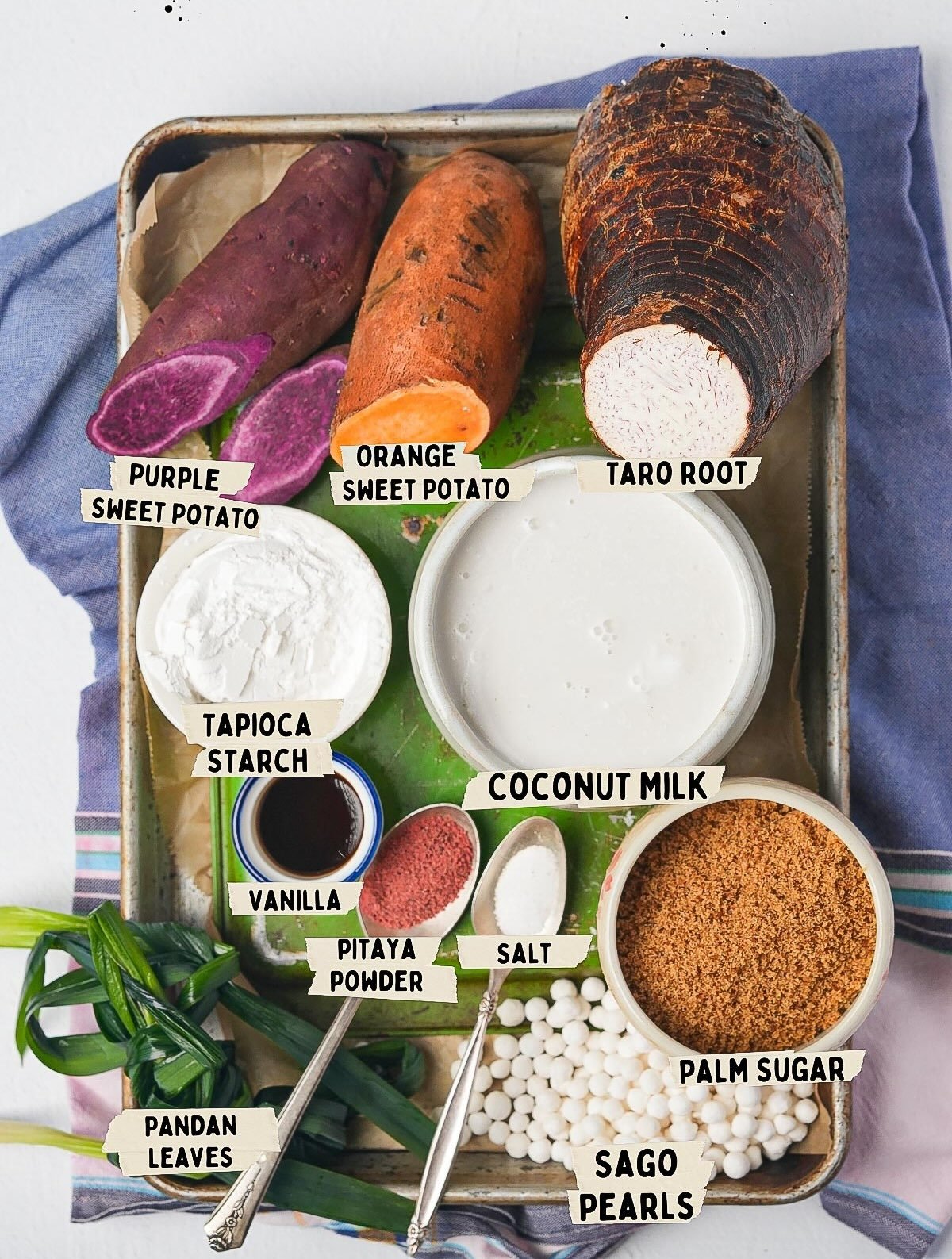
Pitaya Powder
Pitaya powder, made from freeze dried dragon fruit, adds a vibrant pink hue to your Bubur Cha Cha jellies. It’s not just a pretty face; pitaya is rich in antioxidants, vitamins, and fiber, making your dessert both cute-looking and nutritious. If you can’t find pitaya powder, beetroot powder is a colorful substitute. Or you can use other natural colors such as turmeric or pandan power to take the coloring in different directions without using artificial ingredients.
Purple Yam
Purple yam, known as “ubi ungu” in Malaysia, and “ube” in most of the rest of the world, brings a royal touch to this dish with its striking violet color. It’s naturally sweet and packed with dietary fiber, vitamins, and minerals. If purple yam is elusive, regular sweet potatoes with a little ube extract added to them make a good substitute. Then if you have the extract on hand and don't know wtf to do with it, make these ube mochi donuts!
Taro Root
Taro root, or “keladi,” is the heart and soul of taro pudding, and the little baby taro roots called arbi make a killer taro root sabji. It’s starchy, slightly nutty, and adds a delightful creaminess to the dessert. Nutritionally, taro provides complex carbohydrates and fiber. You can usually find it fresh at Asian grocery stores, but you can also use frozen taro if you can’t get the fresh stuff. In a pinch, you can replace it with peeled cassava.
Pandan Leaves
Pandan leaves, or “daun pandan,” impart a unique fragrance and flavor to the coconut milk base. They are a staple in Southeast Asian recipes such as nasi uduk betawi, nasi minyak, and buko pandan salad. While there’s no perfect substitute for pandan’s distinct aroma, you can use a few drops of pandan extract, which is more readily available.
Sago Pearls
Sago pearls are small, translucent beads made from the pith of various palm trees. They add delightful chewiness to the dessert. While sago pearls are traditional, you can substitute tapioca pearls if needed. Just be sure to follow the cooking instructions for your chosen pearls to achieve the right texture.
*See the recipe card at the bottom of the page for exact quantities, nutritional info, and detailed cooking directions.
🤯Variations
Pandan tapioca starch jelly
Part of the fun of barber cha cha is the little colorful jellies. I have a great recipe for pandan jelly in my che ba mau recipe, which you can cut into tiny semi-translucent thin noodles to add more diverse jelly fun stuff to this.
Black Eyed Peas?!?
No, no, not that terrible band who played the most cringy super bowl halftime show of all time. A lot of people are into putting cooked black eyed peas into their bubur cha cha. And like, there’s nothing wrong with that, uh, it’s just totally 100% not for me. A better use of black eyed peas, in my opinion, is the South Indian dish Olan.
📖 How to make perfect bubur cha cha
Make this perfectly on your first shot by following these step-by-step instructions with important tips. Or you can follow along with the easy-to-print recipe card towards the bottom of this page.

Step One
Steam the veggies:
Either place the the diced sweet potatoes, purple sweet potatoes, and taro in a steamer or a pot with water. Steam or boil them over medium heat for about 15-20 minutes or until they are fork-tender. Remove from the steamer, drain in a colander and set aside.
✅ If you have extra sweet potatoes cut into and need something to use 'em up in, they are great for making these easy vegan sweet potato muffins or picarones with!
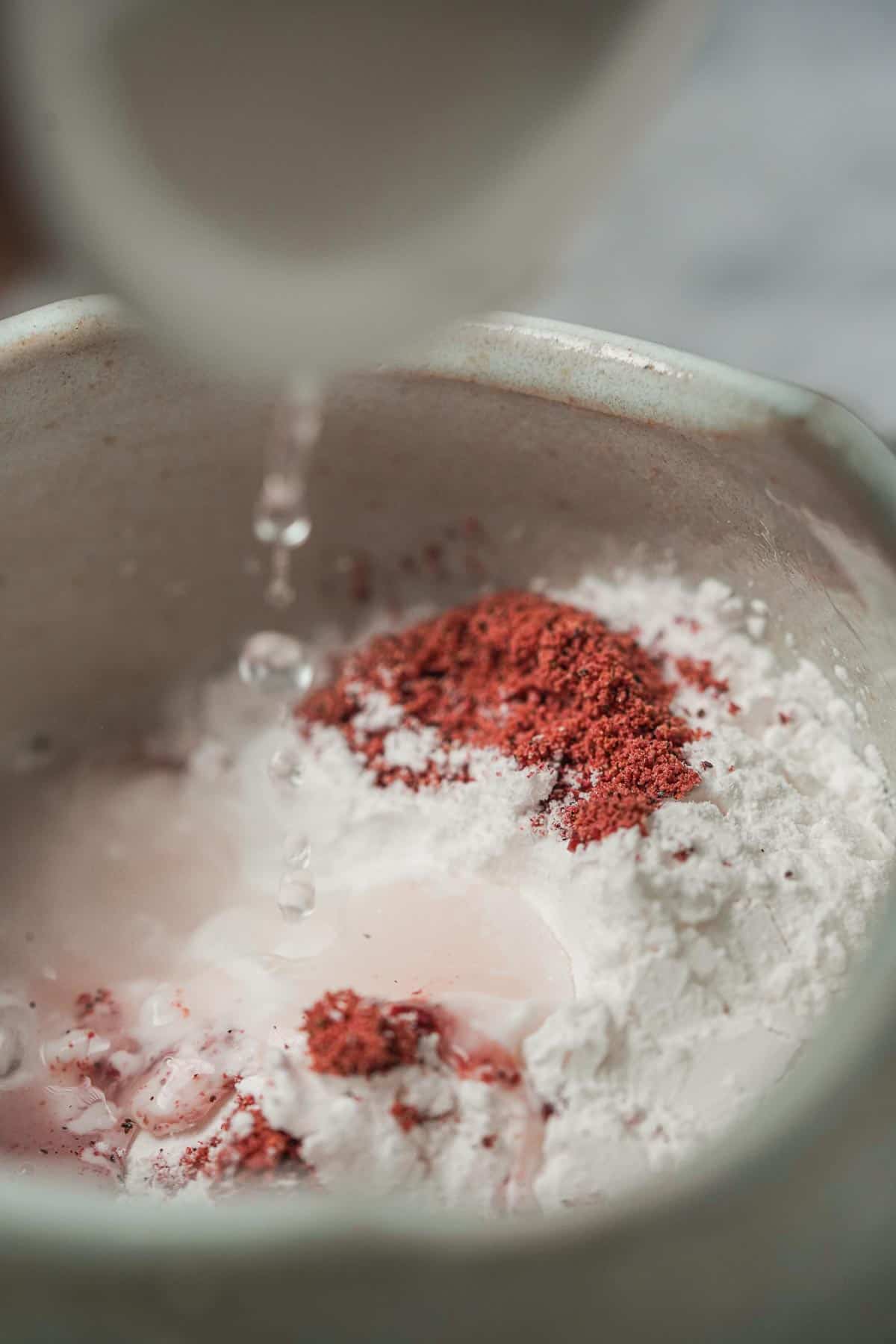
Step Two
Form Jelly Dough:
Place the tapioca starch and pitaya powder (or other coloring that you prefer) into a medium bowl and pour in the hot boiling water. Use a rubber spatula to mix until it forms a dough. Transfer the dough onto a work surface lightly floured with tapioca starch, and knead the dough using your hands until smooth.

Step Three
Form the Jellies:
Roll each half into small balls or shape them as desired. One option is to roll them out using a little extra starch to ensure they don’t stick to the work surface or rolling pin, and use tiny cutters to cut them into fun shapes.

Step Four
Cook the Jellies:
In a small pot, bring water to a boil. Add the tapioca jellies and cook for approximately 10-15 minutes or until they rise to the surface. Once they’ve floated to the top, strain the jellies and set them aside in a clean bowl to cool.

Step Five
Prepare the Coconut Cream:
Combine the coconut sugar (or palm sugar or brown sugar), pandan leaves, coconut milk, vanilla extract, and salt in a saucepan. Bring this mixture to a gentle simmer over low heat. Stir for 4-6 minutes, until the sugar has dissolved. Then remove the pandan.

Step Six
Thicken that C.R.E.A.M. get the money, dollar dollar bill y’all
Mix the water and tapioca starch, and add the starch slur to the coconut milk in the pot. Cook for an additional couple of minutes until the sauce thickens slightly. Set aside.

Step Seven
Cook the Sago Pearls:
In a separate pot, bring the water to a boil. Add the sago pearls to the boiling water and cook them according to the directions on your package.
✅ All brands have a slightly different method. The ones I use need to be boiled for a about an hour on medium heat, or until they turn translucent. Stir occasionally to prevent sticking. Once cooked, drain and rinse the sago pearls under cold water to stop the cooking process. Set them aside.

Step Eight
Assemble the Bubur Cha Cha:
In serving bowls, place a generous portion of the steamed sweet potatoes, purple sweet potatoes, and taro.
Add a few pieces of the tapioca jellies, including the pink ones, for a pop of color. Spoon the cooked sago pearls over the top, and add a couple of neatly placed pieces of steamed purple sweet potato and tapioca jellies, just so that it looks as cute as possible!
💡Serving Ideas
Bubur Cha Cha makes a slammin’ cute dessert after a meal of mee rebus or lontong sayur lodeh, a comforting Indonesian vegetable stew with banana leaf compressed rice cakes. Serve an entree of sambal goreng tempeh, or Tahu goreng over nasi kunyit and follow ‘er up with this classic Malaysian sweet.
For those looking to explore Southeast Asian desserts further, consider pairing Bubur Cha Cha with treats like martabak manis (Indonesian chocolate and peanut stuffed pancakes), turon (Filipino banana and jackfruit spring rolls) or even bành flan (the Vietnamese version of creme caramel).
👉Top tips
- Mind Your Steam Time: Ensure that you steam the sweet potatoes, purple sweet potatoes, and taro just until they are fork-tender but not fally-aparty soft.
- Balance the Coconut Cream: Adjust the sweetness of the coconut cream to your preference. If you like it sweeter, add a bit more sugar, but do so gradually to avoid overpowering the other flavors. Taste-testing is key!
- Texture Matters: Pay attention to the texture of your sago pearls and tapioca jellies. The sago pearls should be translucent, and the tapioca jellies should be chewy but not overly dense. Follow the recommended cooking times and test for doneness.
- A Cute Presentation is Key: Take the time to arrange the steamed ingredients, tapioca jellies, and sago pearls attractively in serving bowls or cups. Opt for glass to serve this in so you can see all the pretty stuff inside. Be creative. Small chilled mason jars are a good option.

🤷♀️FAQ
Sago pearls and tapioca pearls are visually almost identical but not the same. They are both starchy pearls used in cooking and baking, but they come from different sources and have some differences in texture and preparation.
Sago pearls are made from the pith of various types of palm trees, primarily the sago palm, whereas tapioca pearls are made from the starch of cassava root.
Sago pearls tend to be larger and have a distinct translucent appearance when cooked. Tapioca pearls are typically (but not always) smaller and a little more opaque when cooked. They have a chewy, slightly gummy texture.
Absolutely! Make the components for Bubur Cha Cha in advance and store them separately in the refrigerator. Layer them and serve them “fresh to order” so that they can still be as pretty-as-can-be.
Tapioca jellies and sago pearls are best enjoyed fresh, but you can store them separately in an airtight container in the refrigerator for up to 2 days.
I can't recommended freezing Bubur Cha Cha. Freezing can alter the texture and consistency of the ingredients, especially the jellies and steamed starchy vegetables.
✌️My faves to serve with this bubur cha cha recipe:

Malaysian Bubur Cha Cha (Taro, Sweet Potato and Coconut Milk Dessert)
Equipment
Ingredients
Steam:
- 1 medium sweet potato (200 grams) peeled and diced
- 1 medium purple sweet potato (150 grams) peeled and diced
- 1 cup Taro (200 grams) peeled and diced
Tapioca Jelly:
- ⅓ cup tapioca starch 50 grams, aka tapioca flour
- 1 teaspoon pink pitaya powder
- 3 tablespoons water boiling
Coconut cream:
- 1 cup coconut sugar (120 grams) or palm sugar, or brown sugar
- 4 Pandan Leaves
- 400 ml Coconut Milk
- 1 teaspoon vanilla extract
- ¼ teaspoon salt
- 1 cup water
- ⅓ cup tapioca starch
Sago Pearls:
- 2 cups water boiling
- ½ cup sago or tapioca pearls or tapioca pearls
Instructions
Steam the veggies:
- Either place the the diced sweet potatoes, purple sweet potatoes, and taro in a steamer or a pot with water. Steam or boil them over medium heat for about 15-20 minutes or until they are fork-tender. Remove from the steamer, drain in a colander and set aside.
Prepare the Tapioca Jellies:
- Place the tapioca starch and pitaya powder (or other coloring that you prefer) into a medium bowl and pour in the hot boiling water. Use a rubber spatula to mix until it forms a dough. Transfer the dough onto a work surface lightly floured with tapioca starch and knead the dough using your hands, until smooth.
- Roll each half into small balls or shape them as desired. One option it to roll them out using a little extra starch to ensure they don’t stick to the work surface or rolling pin, and use tiny cutters to cut them into fun shapes.
- In a small pot, bring water to a boil. Add the tapioca jellies and cook for approximately 7-8 minutes or until they rise to the surface. Once they've floated to the top, strain the jellies and place them in a clean bowl for later use.
Prepare the Coconut Cream:
- In a separate saucepan, combine the coconut sugar (or palm sugar or brown sugar), pandan leaves, coconut milk, vanilla extract, and salt. Bring this mixture to a gentle simmer over low heat. Stir 4-6 minutes, until the sugar has dissolved.
- Mix together the water and tapioca starch, and add the starch slurry to the coconut milk in the pot. Cook for an additional couple of minutes until the sauce thickens a little bit. Set aside.
Cook the Sago Pearls:
- In a separate pot, bring the water to a boil. Add the sago pearls to the boiling water and cook them according to the directions on the package. Different brands require different cooking times. The large ones I use need to be boiled and then simmered over low heat for about 60 minutes, or until they turn mostly translucent. Stir occasionally to prevent sticking. Once cooked, drain and rinse the sago pearls under cold water to stop the cooking process. Set them aside.
Assemble the Bubur Cha Cha:
- In serving bowls, place a generous portion of the steamed sweet potatoes, purple sweet potatoes, and taro. Add a few pieces of the tapioca jellies, including the pink ones for a pop of color. Spoon the cooked sago pearls over the top. And top with a couple of neatly placed pieces of steamed purple sweet potato and tapioca jellies, just so that it looks as cute as possible!
Notes

Enter your email & I'll send it to your inbox. Plus, get great new recipes from me every week!
By submitting this form, you consent to receive emails from Cinnamon Snail.


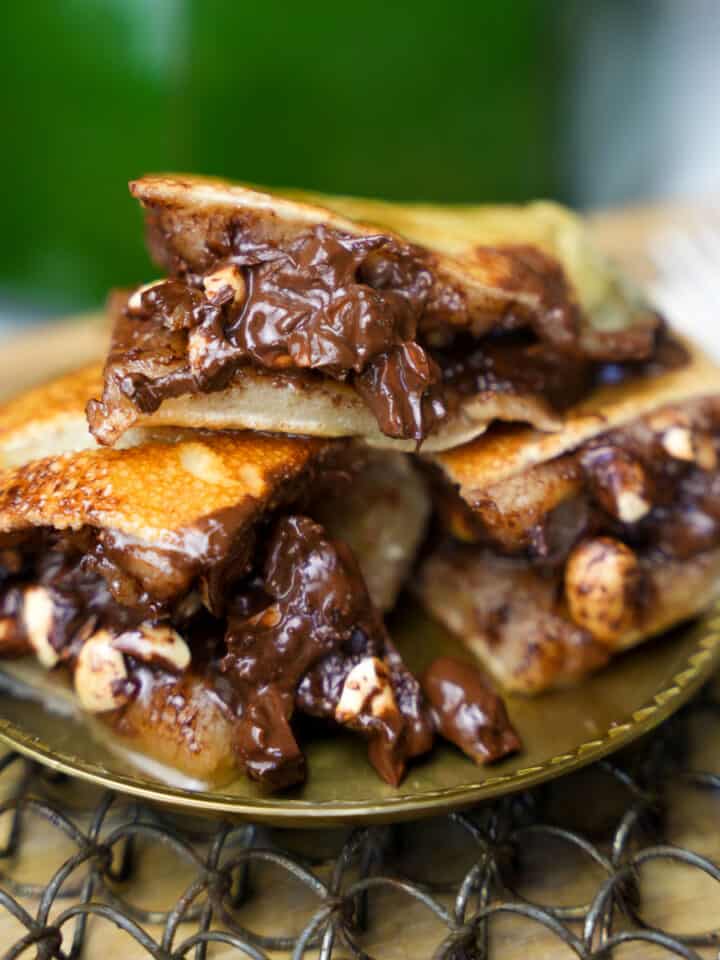

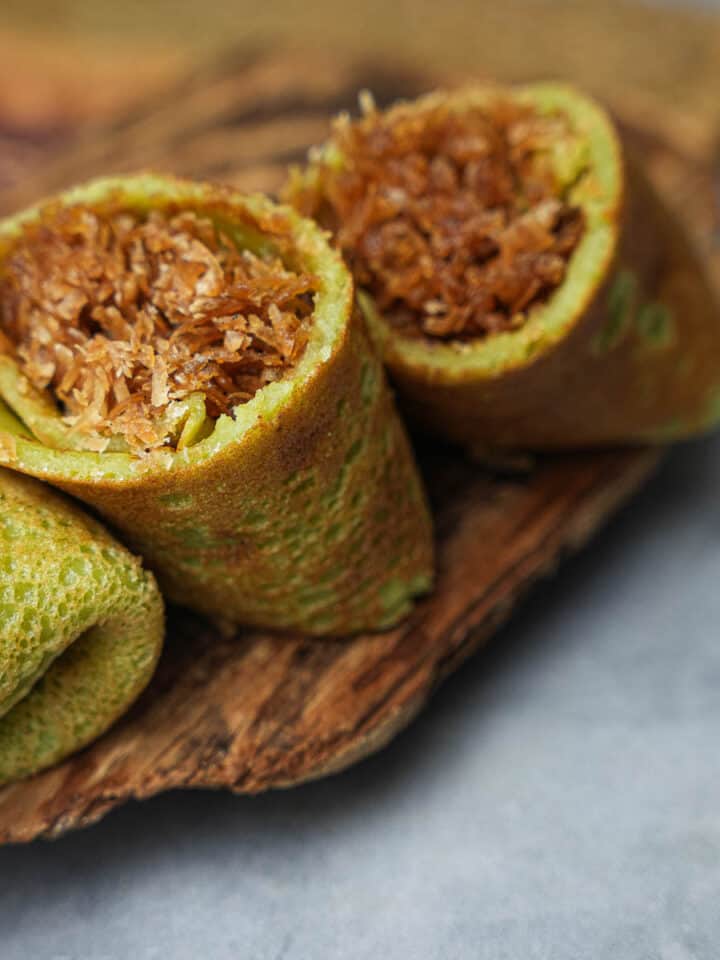


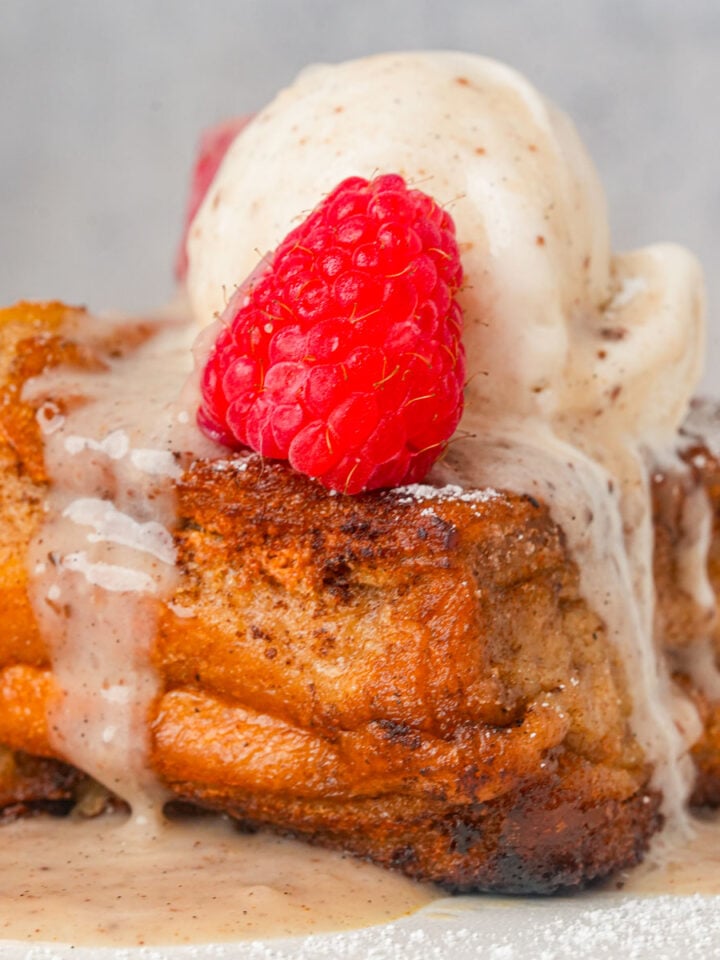



Leave a Reply